If universe is a) infinite and b) uniformly filled with stars Any line of sight will end on a star, so night sky will be bright
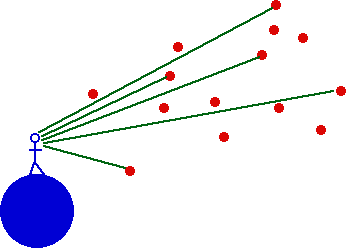
A Creation Myth???????????
In the beginning the Universe was created. This has made a lot of people very angry and has been widely regarded as a bad move. Many people believe that it was created by some sort of God, though the Jatravartid people of Viltvodle Six firmly believe that the entire Universe was in fact sneezed out of the nose of a being they call the Great Green Arkleseizure.
The Jatravartids, who live in perpetual fear of the coming of a time that they call The Coming of the Great White Handkerchief, are small blue creatures . However, the Great Green Arkleseizure theory was not widely accepted outside Viltvodle Six, and so one day a race of hyper-intelligent beings built themselves a gigantic computer called Deep Thought to calculate once and for all the answer to the Ultimate Question of Life, the Universe and Everything.
which was, of course, 42.
From "The Hitchhiker's Guide to the Galaxy", Douglas Adams
Ingredients for a creation myth
Space is big. Really big. You won't believe how vastly, hugely, mind-bogglingly big it is.
Hitchhiker's guide to the Galaxy.
How big? Could it be infinite?
Olber's Paradox Why is the sky dark at night?
If universe is a) infinite and b) uniformly filled with stars Any line of sight will end on a star, so night sky will be bright |
 |
But it isn't !
Apparent Ways out:But it is for galaxies
| Light from stars falls off as inverse square law 1 r² But the number of stars increases as r² so the effects cancel |
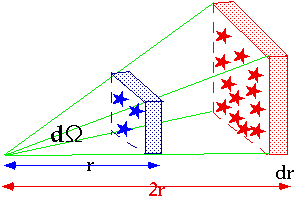 |
But the matter would by now be hot & radiating
| Light is redshifted to very long wavelengths so objects within ~ 3000 Mpc will have any visible radiation at all But this implies that the universe must be expanding |
 |
| Very distant objects would correspond to an age of more than 10 billion (1010) years
No reason why the universe should be the same then |
.gif) |
Atoms => Stars => Galaxies=> =>Clusters=>Superclusters
At each stage the distribution becomes more regular, and finally there is no evidence that superclusters clump
Note: this is a hope, not even an observation! Out to the largest scales we could observe reliably pre 1985,
d ≈ 1 Gpc or z ≈ 0.2c,
there are still voids on the largest observable scale. But IRAS says δM/M < 0.001, and COBE gives δM/M = 0.000011
How can we tell if the universe will expand forever? or....
The water beetle was sent on an exploration, and after darting about on the surface and finding no rest, it dived down to the depths, whence it brought up a bit of mud, from which the earth grew by accretion.
Apache Creation Myth
Redshift:
Slipher-Hubble-Humason found light from most galaxies is redshifted. The Doppler effect gives z = (λ-λ₀)/λ₀ = Δλ/λ₀
Velocity of recession: v = zc = Δλc/λ₀
Hubble
found vel. of recession ∝
distance zc = Hd = v H ~ 65kms-1/Mpc 1 Mpc (megaparsec) = 3x1022 m |
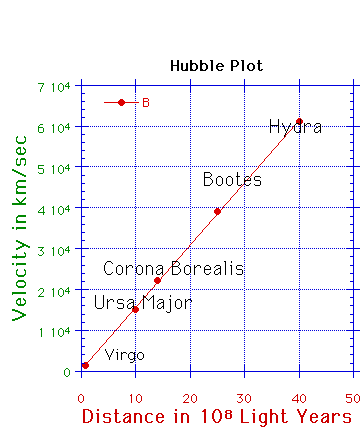 |
| Note although all galaxies are receding from us, does not imply we are at the centre: in the currant cake model all currants see all the others as recediing |  |
RULE 1 in Physics 100: Never mix your units!)
H = 65x10³ = 1.8x10-18 (m s-1)/m
3.1022
We can invert this to give H-1 = 5.4x1017 s = 1.7x1010 yr. What does this time represent? |
 |
Must be age of universe: if expansion does not change i.e. 17x109 yr ago, all the galaxies were in the same place. Universe had a beginning, implied by the big bang. Can run Hubble expansion back: we would like to use this to predict what will happen in the end |
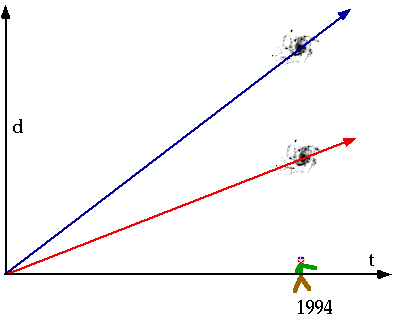 |
Where was the Big Bang?

A 2-D analog is the surface of a balloon: it has no centre in 2-D space. Deflating it reduces it to zero size
At the moment of the big bang, not only matter was created, but also space and time
Early universe must have been very simple: there can have been no stars or galaxies. However, it was very hot: hot things radiate....
If we measure from now (t = t₀) then R = 0 when t = t₀ - 1/H₀ independent of R₀. Gravitational attraction would have slowed expansion since the early universe. So Hubble's constant is important: we had better be sure of what it is!
(Incidentally, it isn't a constant...when the universe was smaller, R was less; if v was constant H must have been bigger)
Originally Slipher-Hubble-Humason found d for nearby galaxies via Cepheids
=> H₀ = 550 kms-1/Mpc
=> 1/H₀
But there are 2 kinds of Cepheids.
LII < LI, MI = MII - 2, for the same period.
Type II seen locally, type I rarer and the only ones that can be conveniently seen in external galaxies.
Identification lead to H₀ => H₀/4 ≈ 125
Subsequent measuring of absorption => H₀ ≈ 55
(also large bright HII regions mis-identified as stars)
| Long dispute | 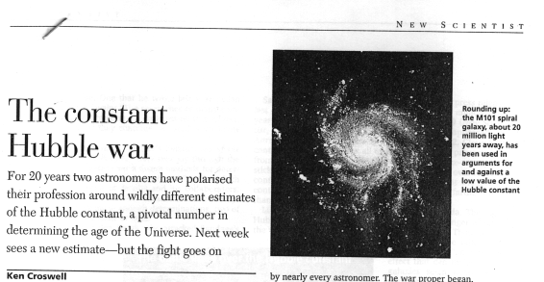 |
Two New Techniques (1979):
| Brightness curve of globulars seems to be common, so by sliding up and down the HR Diagram, we can define dist. => H₀ = 80 | 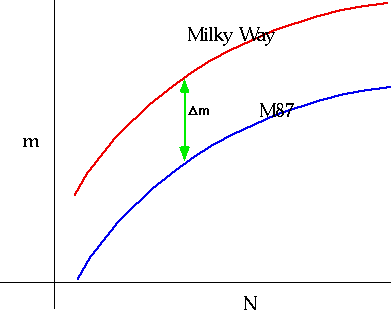
|
| Can measure luminosity (apparent) L', and mass of galaxy: new technique uses 21cm to measure mass: large mass ⇒ high velocity ⇒ wide line L ≈ L1 M/M1 where L1 and M1 are the results for our galaxy. Given apparent luminosity L', and absolute luminosity L from 21cm width, can get d |
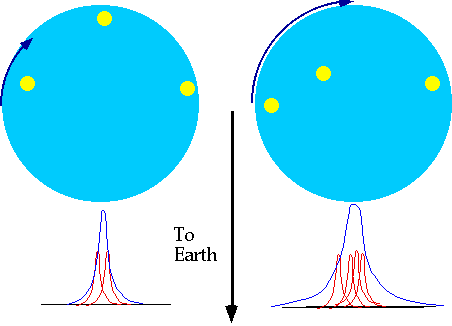 |
gives H₀ ≈ 55 kms-1/Mpc
1/H₀ ≈ 13x109 yrs
Also implies that we have an anomalous velocity with respect to Virgo cluster: i.e. we are falling towards it at ≈ 200 km s-1
| Sadly no one agreed! H = 50 or H = 85 H = 100 h km s-1 Mpc-1, where h is a number between .45 and .95 |
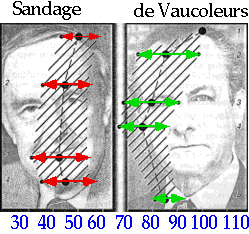 |
The sky becomes black, Earth sinks into the sea From Heaven fall the bright stars The sea ascends in storm to Heaven It swallows the Earth, the air becomes sterile
From the Hyndluljod (Iceland)
How can we tell if the universe will expand forever?
As a model, consider this as an escape velocity problem. How hard do we need to throw a galaxy on the "outside" so that it escapes? Note: our calculation had better not depend on r! 1 mv² - GMm = 0 2 rbut v = Hr and the total mass of the universe inside
M = 4π/3 ρ r³ |
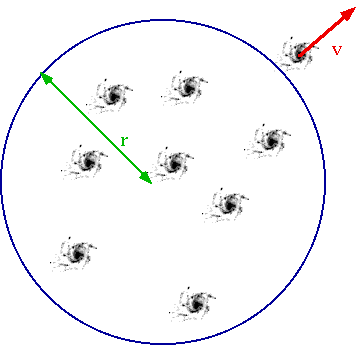 |
so...
H²r² = 2G4π/3 ρ r²
(we got lucky: the r cancels out!). We can turn this round and write it as an equation for ρ
ρ₀ = 3 H²
8π G
Hence the critical density
ρ₀ ~ 6 x 10-27 kg m-3 ~ 3.6 Hydrogen Atoms m-3 (Number is flaky:we'll use 3). Also use
Ω = ρ
ρ₀
because some errors cancel out. The entire future of the universe is given by this one number!!!!!!!!!
So if
More important:we live forever if Ω ≤ 1, (well maybe). |
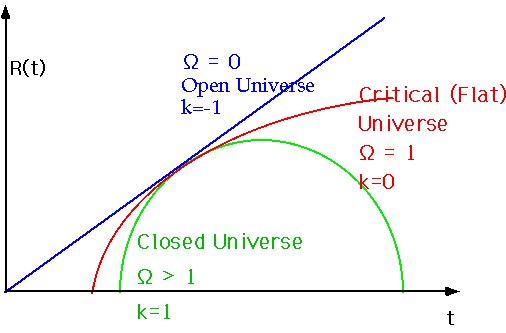 |
Note that this implies that the rate of expansion must change
Gravity will slow down expansion in the early stages |
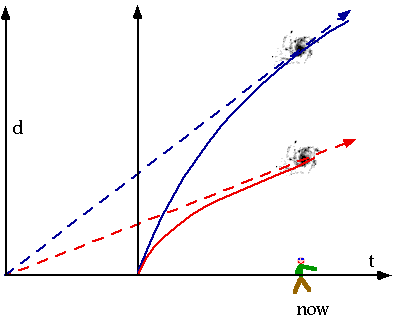 |
From this (incredibly naive) model we can deduce:
Universe is "full" of light: fossil light from Big Bang, discovered accidentally by Penzias and Wilson (1964) |
 |
Found that "noise" came from universe independent of what angle horn was pointed in: corresponded to a black-body temp of 30K Have to get above atmosphere and point away from Milky Way. |
 |
| Have to get above atmosphere and point away from Milky Way
Subsequent values came from balloon flights: Finally COBE launched 1990: Note the perfect Black Body curve. |
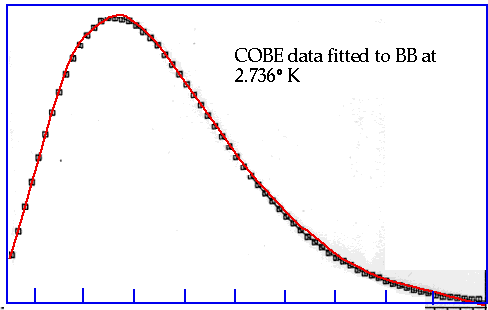 |
Where does it come from?
Gamow (1948) discussed Hot Big Bang for first time, suggested that E.M radiation from it should still be observable. Peebles (1964) had calculated that it should be observable, but thought T ~ 10 0K, (and everyone had general feeling that it would be unobservable).
This is often the way it is in physics: our mistake is not that we take our theories to seriously, but that we do not take them seriously enough. It is hard to believe that the numbers that we play with at our desks have something to do with the real world. Steven Weinberg The First Three Minutes
This "light" is now at 2.736°K, and almost uniform in every direction. It was emitted just 500000 years after the Big Bang and has been travelling round the universe ever since<. At time t₀, the universe is full of γ's at a temperature T₀.
As the universe expands, the density of γ's decreases.ρ(t) = ρ₀ R₀³/R(t)³ and also the temperature T falls as each γ gets redshifted |
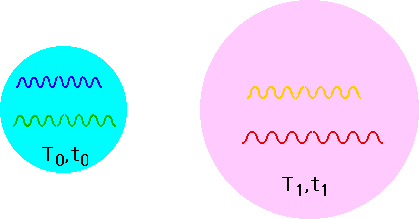 |
Hence the energy density E(t) ∝ R(t)⁴
More exactly: from the Black Body equation:
Energy density:
u = T⁴ × 8/15π5k⁴/(h³c³) = aT⁴ = 4σT⁴/c(Stef.-Boltz.)
Mean γ-energy E ≈ 2 x 10-4 T eV
actually = hc/λ = 6.58x10-16 x 3x108 /λ
Peak of BB curve is at λ = 2.898x10-3/T
Now, the peak is at 1.05 mm: what is the temperature, N, E, ρ?
It is believed that the first nine inhabitants who had descended from the skies were sexless and sinless and lived on a kind of flavoured earth. Their appetites grew and when they took to eating a sort of huskless rice which cooked itself they became gross and heavy, devloped sex and after it crime because they had to work for a living
Kachin Myth
Early universe must have been very simple:
a) No distortion from B-B spectrum (results have to be divided into pre and post COBE)
b) Zeldovich - Sunayev effect: Temp of B-B falls in direction of galaxy due to Compton scattering
| c) Dipole effect: if we are moving through CMBR we would expect to see it "warmer" in front and "colder" behind | 
|
| so CMBR is blue-shifted in the direction we are going in (note residual effect of galaxy) | 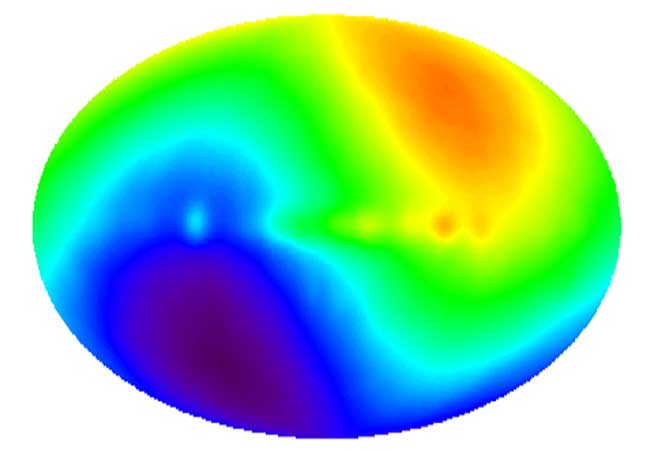
Credit: DMR, COBE, NASA, Four-Year Sky Map |
| shows we are moving towards Leo at≈ 606 km/s | 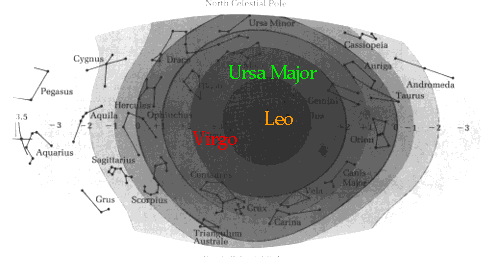 |
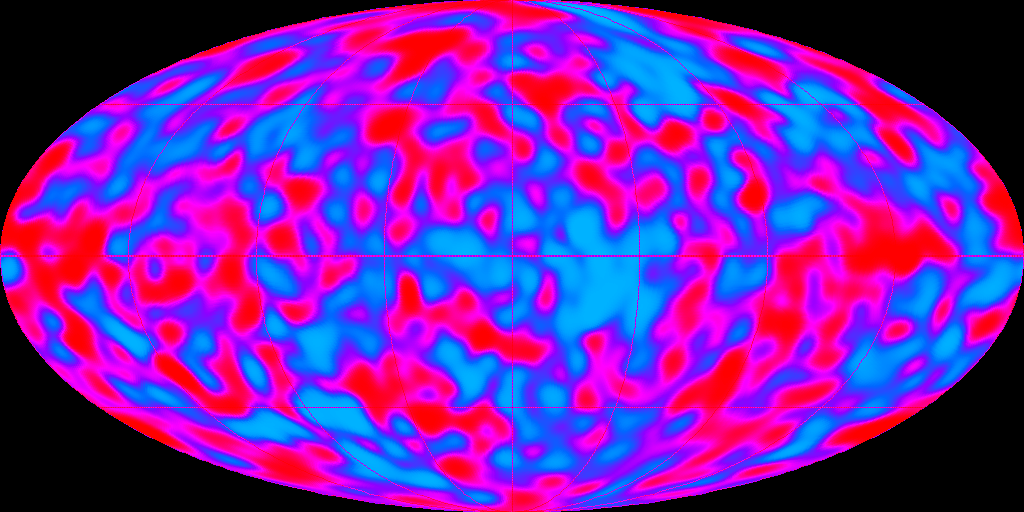 Except there is a tiny problem: some of the features in the CMBR seem to be aligned with the solar system....
Except there is a tiny problem: some of the features in the CMBR seem to be aligned with the solar system....

Steady state theory of Bondi, Hoyle, Gold
| Basic assumption is that universe is not only isotropic in space, but also in time: i.e. it always looked much the same
How can this be squared with expansion? Imagine a stream of water falling into full bucket: 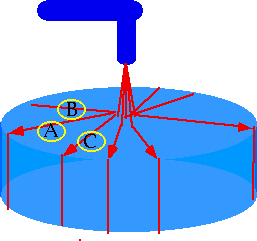 Requires creation of new Matter |
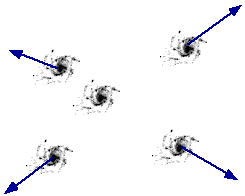 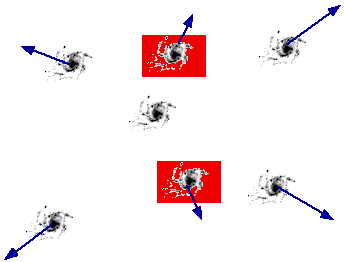 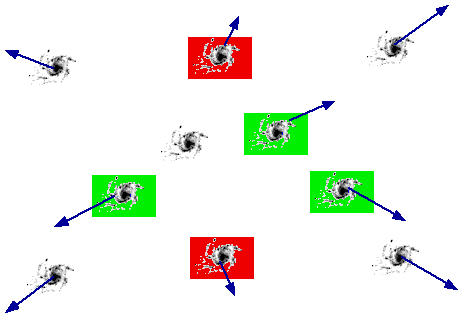 |
approx. 10-35gm cm-3/sec averaged over space, or 1 H atom/c.c. every 10⁴ yr., which is undetectable.
Does not conserve energy (in usual sense).
Also predicts expansion should be accelerating (or q₀ < 0)
Can't produce CMBR .
Will see later on how to model this